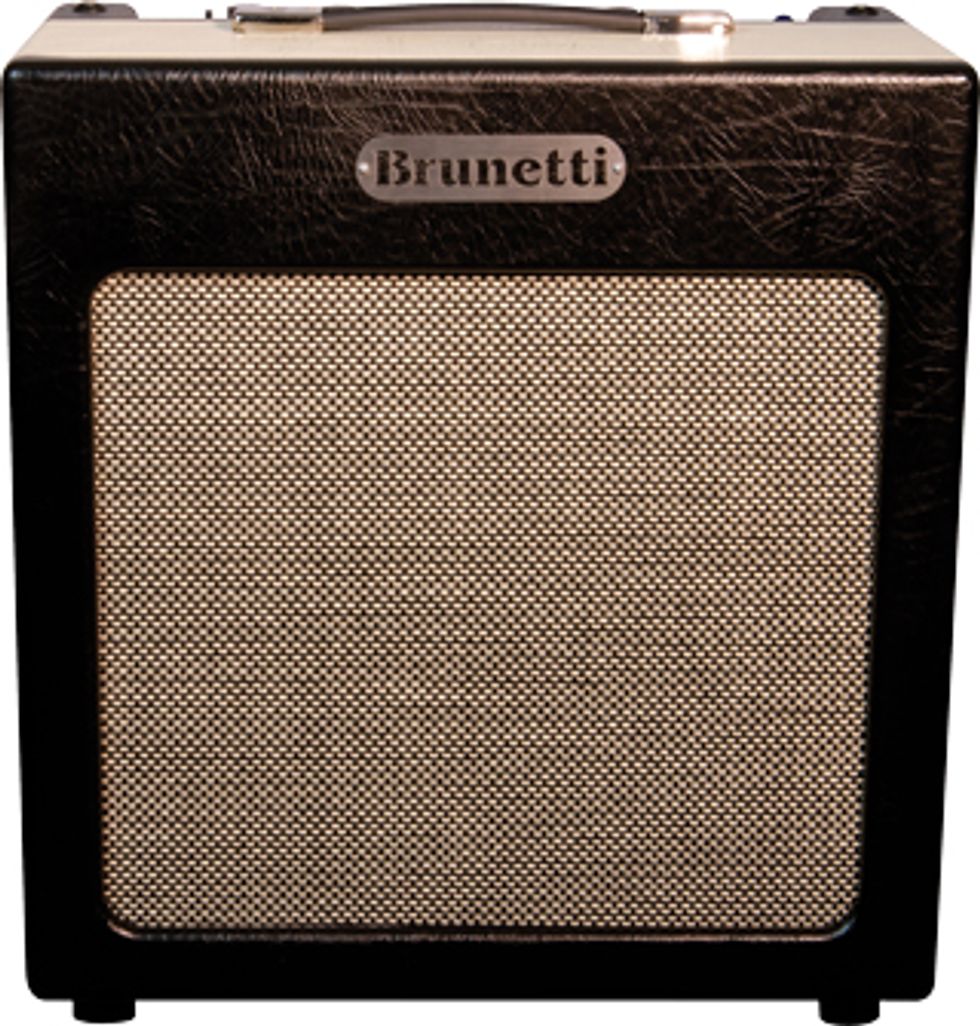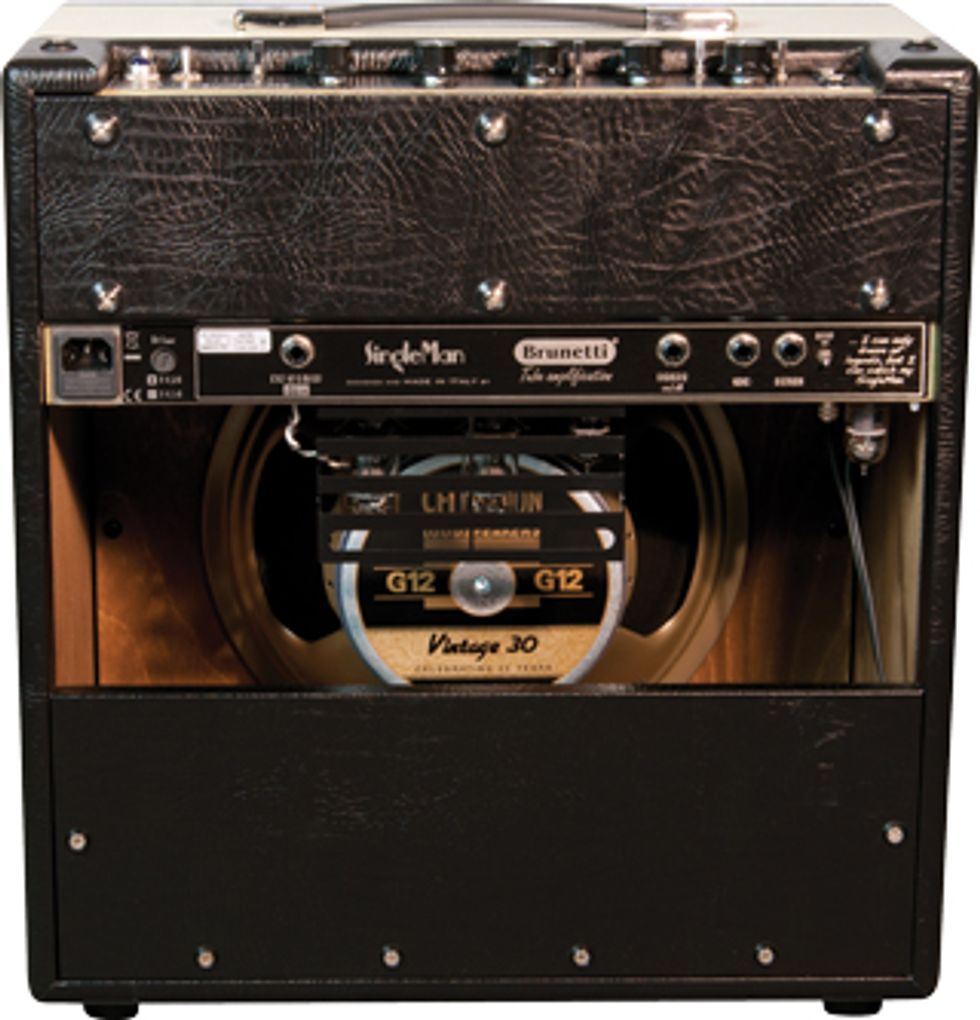
For many players, it’s difficult to resist the enthralling clean tones of a blackface Fender amp. There are many reasons why those classic amps have made generations of guitarists salivate—their rich warmth, sparkly highs, and springy response, for starters. Their sonic qualities have driven builders since before the dawn of the boutique amp age, all of them hoping to capture a sliver of what made those amps great.
But mimicry only goes so far, and Brunetti Amplification didn’t want their new class A, 6V6-powered Singleman combo to be a simple clone of a classic. Although the 16-watt 1x12 combo (a 35-watt, 6L6-powered version is also available) shows an obvious affinity for those tones, it really uses them as a foundation for its own voice, throwing in a couple of extra features to expand its sonic palate.
The Singleman oozes class with the black-and-tan motif of its Celestion Vintage 30-stocked, semi-open back cabinet. Brunetti says it weighs almost 40 pounds, but it feels a bit lighter. It also features a jack for connecting a 16 Ω cab.

Inside the stainless-steel chassis, the Singleman uses top-shelf components—sealed relays, Red Series MKP WIMA caps, and low-noise film resistors—in a handwired circuit governed by a dual 12AX7-driven, 3-band EQ section with a few tricks up its sleeve: Although the amp might seem limited to some players because it has just one channel, it serves up more versatility via its midrange-boost and brightness switches, as well as a 3-way switch for selecting tweed, fat, or smooth voicing modes. Tonal and application flexibility are further bolstered by the Singleman’s PowerLimit circuit—a patented system for switching the tubes from push-pull tetrode (16 watts) to triode (12 watts) and single-ended triode (1-watt) modes. There’s also a seriously great-sounding Accutronics spring reverb, and a serial effects loop.

The Classics … Reborn
The Singleman’s tones—scooped cleans
with deliciously smooth breakup—conjure
thoughts of a trusty ’60s Deluxe
Reverb bellowing over an audience in a
smoky blues bar. The P-90s in a Gibson
SG Classic push the front end very nicely,
allowing the amp’s woody attack and
mids to shine through. The EQ controls
are well voiced and dynamic, too, so it
doesn’t take much tweaking to get tones
that can cover jazz, blues, country, and
rock—especially if you dedicate your
attention to the amp’s midrange control
(more on that in a bit).
Evidence of the EQ’s dynamics is evident as you travel from one extreme to another on each knob. A perfect example is how immediate the attack becomes when treble is turned past 3 o’clock—it yields a snappy top end perfect for country fingerpicking. Increasing the bass lays down a luscious low end that works well with neck-position single-coils for jazzy rhythms, and the amp reacts with authority when you pick the strings hard. Meanwhile, the middle control is great for tailoring the Singleman’s voice for a specific guitar: For example, lower settings accommodate a Gibson Les Paul, balancing its lows and highs, while boosting it above 1 o’clock fattens the tone enough for a Stratocaster’s bridge singlecoil to handle jazzier fare.
Ratings
Pros:
Brilliant cleans and lush overdrive. Deep spring
reverb. Blackface deluxe Reverb tones with more tweakability.
Cons:
Difficult to dial in settings that can yield both punchy
overdrive and clean tones.
Tones:
Versatility:
Build:
Value:
Street:
$1,419
Brunetti
brunetti.it
The Singleman’s reverb is deep and lush, rivaling that of a venerated old Deluxe or Twin—though some players might feel there’s too much on tap. Setting it between 9 and 10 o’clock adds a nice, three-dimensional quality that helps carry the tone across the room—it’s likely plenty for most jazz, blues, and country players. When it approaches noon, you get into splashy surf-rock territory. If you like drowning your sound in reverb, the amp can yield mammoth-sounding results.
Given the inspiration for its design, one might assume that the Singleman’s main mission is to deliver beautiful, vintage-style cleans, but its overdriven tones are nothing to turn your nose up at, either. Single-coils and humbuckers both have a fantastic vintage bite in the highs, and the smooth midrange setting sags in a really pleasing way when the volume is up high enough to yield some dirt. The 3-way voicing switch is indispensable for honing the drive’s flavor—it delivers some of the amp’s coolest tones. I particularly liked the tweed setting, with volume at 1 or 2 o’clock and a pair of P-90s driving it all—it’s one of the coolest, most refined riffs on a cranked Deluxe sound that I’ve ever heard.
Because Singleman doesn’t have a master volume, the only way to get overdrive is to turn the volume up until the power amp saturates. That’s where the PowerLimit circuit comes in handy. But the lower you go, the more the driven tones sag, which affects the amp’s punchiness. So finding a good overall volume on the amp and riding your guitar’s volume knob is key for getting both clean and dirty tones.
The Verdict
With the Singleman, Brunetti has fashioned
an excellent tribute to blackface
Fenders, one that shakes up the formula
with superb harmonic detail, a little extra
grit, more versatile tone-shaping features,
and practical power attenuation. Combine
that functionality with classy looks, roadworthy
build quality, and a very reasonable
price, and it’s a compelling option for studio
hounds and road warriors alike.












![Rig Rundown: Russian Circles’ Mike Sullivan [2025]](https://www.premierguitar.com/media-library/youtube.jpg?id=62303631&width=1245&height=700&quality=70&coordinates=0%2C0%2C0%2C0)







